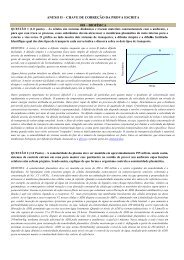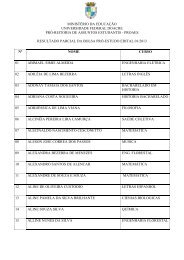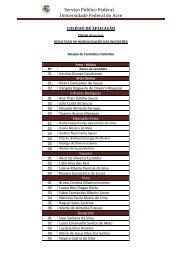Revista Brasileira de Ornitologia - Universidade Federal do Acre
Revista Brasileira de Ornitologia - Universidade Federal do Acre
Revista Brasileira de Ornitologia - Universidade Federal do Acre
Create successful ePaper yourself
Turn your PDF publications into a flip-book with our unique Google optimized e-Paper software.
444First record of Augastes scutatus for Bahia refines the location of a purported barrier promoting speciation in the Espinhaço Range, BrazilMarcelo Ferreira <strong>de</strong> Vasconcelos, An<strong>de</strong>rson Vieira Chaves and Fabrício Rodrigues <strong>do</strong>s Santos(1995) suggested that a vicariant event in the EspinhaçoRange region would be the responsible for their speciation.Meanwhile, until recently, there was a gap of more than300 km between the ranges of these two species ofAugastes in the Espinhaço Range (between Grão Mogol,Minas Gerais, and the southern Chapada Diamantina,Bahia). Thus, it was not possible to infer what would bethe geographical barrier that led to this probable vicariantevent. Later, Vasconcelos (2008) collected specimens ofA. scutatus in the extreme northern Minas Gerais (Serra<strong>do</strong> Pau D’Arco), and this gap was reduced to 180 km.Here, we report on the northernmost record to date forA. scutatus, which provi<strong>de</strong>s insights on the purportedvicariant barrier responsible for the speciation of bothAugastes species in eastern Brazil.MATERIAL AND METHODSBetween 4 and 7 January 2011, we collected birdspecimens at Morro <strong>do</strong> Chapéu (between 14°52’44”S/42°30’15”W and 14°54’11”S / 42°31’33”W), a mountainlocated in Jacaraci municipality, southern Bahiastate. Specimens were collected with air-compressedcarbines, prepared as study skins and <strong>de</strong>posited at theornithological collections of the Department of Zoologyof the Universida<strong>de</strong> Fe<strong>de</strong>ral <strong>de</strong> Minas Gerais (DZUFMG)and of the Museu <strong>de</strong> Ciências Naturais da PontifíciaUniversida<strong>de</strong> Católica <strong>de</strong> Minas Gerais (MCNA), bothin Belo Horizonte, Minas Gerais, Brazil.RESULTS AND DISCUSSIONOn 5 January, a male of A. scutatus (DZUFMG 6668)was collected in a campo rupestre area at Morro <strong>do</strong> Chapéu(14°53’44”S; 42°30’59”W; elevation: 1,325 m). On thenext day, another male (MCNA 1314) was collected onthe mountain-top (14°54’00”S; 42°31’05”W; elevation:1,430 m). These are the first records of this species inBahia state, narrowing the gap between its range and thatof its northern supposed allospecies (A. lumachella) toonly about 150 km (Figure 1).Other species of plants and amphibians also sharea similar pattern of distribution of these two putativehummingbird allospecies, whereby a species occurs in thecentral-southern portion (in Minas Gerais state) while theother is distributed in the northern section (in ChapadaDiamantina region, Bahia state) of the Espinhaço Range(Harley 1995, Lugli & Haddad 2006a, b, Leite et al.2008). Some authors (e.g., Rapini et al. 2008, Ribeiro etal. 2008) admit that the disjunction between the camposrupestres of Minas Gerais and Bahia would be of 300km, with a lowland barrier imposed by the valleys of theContas, Par<strong>do</strong> and Jequitinhonha rivers, all covered withxerophytic Caatinga and other semi-<strong>de</strong>ciduous forestvegetations. These dry valleys would promote the vicarianceof these taxa insi<strong>de</strong> the Espinhaço Range and also preventfloristic and faunistic exchange between the centralsouthern(Minas Gerais) and northern (Bahia) sections ofthis mountain range (e.g., Harley 1988, Borba et al. 2001,Lugli & Haddad 2006a, b, Rapini et al. 2008, Ribeiro etal. 2008). Nevertheless, the recent records of A. scutatus insouthern Bahia show that this possible disjunction is onlyhalf (c. 150 km) of the original presumed distance, andwould inclu<strong>de</strong> only the Contas River valley.It is also important to stress that there is a smallplateau in the Caetité region (between 800 and 1,100 m),north of Jacaraci, which could represent a stepping-stonelinking both sections of the Espinhaço highlands (Figure1). Meanwhile, this plateau is pre<strong>do</strong>minantly coveredby typical Cerra<strong>do</strong> (savannah), and there are only smallpatches of rocky outcrops around the village of Brejinhodas Ametistas (with less than 3 ha each) with several typicalCaatinga plants (including several cacti), but only a fewtypical montane plant species, such as Vellozia sp. (M. F.V. pers. obs.). A survey conducted in this area by M. F.V. (between 29 April and 5 May 2008) failed to recordany Augastes. Thus, these small patches of rocky outcropsin the Caetité plateau probably <strong>do</strong> not represent suitablehabitat for any species of Augastes, especially because theylack several plants typical of the habitats used by those twohummingbirds. Also, the lithology of the Caetité plateauis completely different from that of the Espinhaço Range.It is pre<strong>do</strong>minantly composed by Cenozoic sedimentaryrocks of the last 60 million years that have been <strong>de</strong>positedin topographically lower areas in relation to the adjacentEspinhaço mountains (Schobbenhaus 1996, Barbosa et al.2003, Cruz & Alkmim 2007, Caxito et al. 2008). Thus,during the Cenozoic, the plateau in the Caetité region wasnot represented by high mountains, and, even with presentaltitu<strong>de</strong>s above 1,000 m, it <strong>do</strong>es not have any representativearea of campos rupestres typical of the Espinhaço Range thatcould maintain viable populations of plants and animalsassociated to this vegetation type (see Vasconcelos 2011).Thus, this region, together with the Contas lowland rivervalley, originally covered by Caatinga vegetation, is notsuitable for the mo<strong>de</strong>rn occurrence and dispersal of bothspecies of Augastes in the Espinhaço Range, as well as severalother typical campo rupestre plants and amphibians fromcentral-southern (Minas Gerais) and northern (Bahia)sections of this mountain range.The possible vicariance between the two speciesof Augastes may be related to climate changes during thePio-Pleistocene. In this context, it is possible that duringglobal cooling events, taxa of plants and animals typical ofthe campos rupestres, which are currently restricted to themountain-tops, may have survived at lower altitu<strong>de</strong>s (seeHarley 1988, Safford 2007). In this case, an ancestral lineageof the two species of Augastes would be formerly distributedin a wi<strong>de</strong>r area. During one or more warming cycles, this<strong>Revista</strong> <strong>Brasileira</strong> <strong>de</strong> <strong>Ornitologia</strong>, 20(4), 2012










